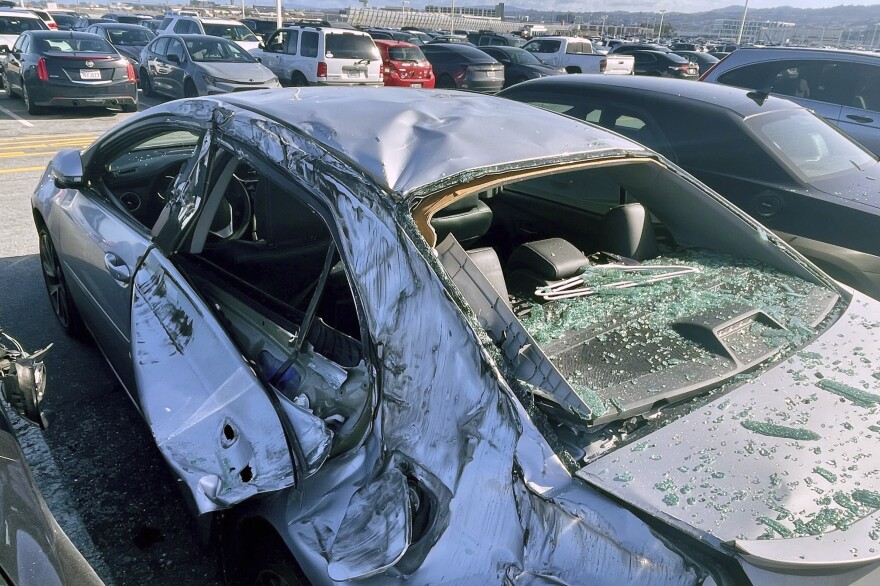Despite a string of high-profile flight mishaps on United Airlines flights in recent days, commercial air travel is still very safe, experts say.
"Planes that we fly on today, they're safer than they've ever been," says Anthony Brickhouse, a professor of aerospace safety at Embry-Riddle Aeronautical University in Daytona Beach, Fla.
This past week, United Airlines was under the spotlight for a series of emergencies: Last Monday, the engine of one of its planes ingested bubble wrap and caught fire in mid-air. On Thursday, a tire of an aircraft fell off and smashed into a parked car shortly after takeoff. On Friday, one of its planes experienced a hydraulics issue.
No one was injured in any of the United incidents. The airline said in a statement that safety is its top priority and it will investigate each event.
The back-to-back emergencies come two months after adoor plug tore offand left a gaping hole during an Alaska Airlines flight. No one aboard was seriously injured.
That plane, along with the jetliners involved in Monday and Thursday's United incidents, was made by Boeing. Meanwhile, the plane involved in Friday's emergency was made by Airbus.
While those recent events paint an unsettling image of the skies, aviation safety experts say it's not the whole picture, and it's not enough to write off Boeing, United or flying in general.
When asked about the recent concerns over flying, Transportation Secretary Pete Buttigieg said federal data shows flight safety has been improving over the years. "American aviation is the safest means of travel in the world," he said at a press conference Monday.

Here's what to know.
Globally, commercial plane accidents and deaths are rare and declining
According to the International Air Transport Association (IATA), a trade association for airlines, the number of accidents involving commercial planes has been going down over the years.
In 2023, the commercial aviation industry saw 30 total accidents, one of which was fatal — 72 people were killed in Nepal in what investigators said was pilot error. A year prior, there were five deadly accidents with 158 fatalities. In 2013, there were 11 fatal accidents causing 638 fatalities, according to the IATA.
To put it differently, the risk of boarding a fatal flight has been getting lower. Arnold Barnett, a statistician at the Massachusetts Institute of Technology who has studied airline safety, tells NPR that from 2018 to 2022, the chances of a passenger being killed on a flight anywhere in the world was 1 in 13.4 million. Between 1968 to 1977, the chance was 1 in 350,000.
"Worldwide flying is extremely safe, but in the United States, it's extraordinarily so," Barnett said.
In the U.S., there has not been a fatal plane crash involving a major American airline since February 2009, though there have been a handful of fatalities since then.
Brickhouse, who has studied aviation safety for over 25 years, often tells people that the biggest risk of any air journey tends to be driving to the airport.
More than 40,000 people are killed on U.S. roads each year.
"Aviation remains the safest mode of transportation," he says.
Planes are designed to keep working even if something goes wrong
Despite a missing tire, an inflamed engine, and a hydraulics issue, all three United Airlines planes were still able to safely land last week.
"Not to minimize these recent events because they each were serious, but aircraft are designed with what we call redundancy," Brickhouse says. "So if one system fails, there's a backup."
According to United, its aircraft are built to land safely with missing or damaged tires. The airline added that the plane with the hydraulics issue had two additional hydraulic systems in place for the same reason.
Pilots and crew are well-trained for emergencies
Just like planes are built to function when something goes awry, flight crews are also extensively trained to know what to do in emergencies.
"There's a big misconception with flight attendants, that they're there to serve us drinks and help us find our seats," Brickhouse says. "The primary role of flight attendants is safety."
He adds that pilots and flight attendants practice both inside and outside the classroom on how to evacuate in water or when the plane is filled with smoke, and even what to do when a laptop catches on fire.
There are steps passengers can take to increase their own safety
Have you ever worn a polyester shirt or heels to a flight? According to Brickhouse, that's exactly what not to wear in case of an emergency.
He says natural fibers such as cotton and comfortable, closed-toe footwear provide an extra layer of protection and coverage in extreme scenarios, like a fire. He also recommends passengers eat a meal before they fly, as it helps with "survivability" if there's an extended time without food available.
On the flight, Brickhouse recommends making sure to listen to the safety briefings and take note of where the emergency exits are. "That only takes a few minutes and then you can get on to what you need to do," he says.
NPR's Joel Rose contributed reporting.
Copyright 2024 NPR. To see more, visit https://www.npr.org.








